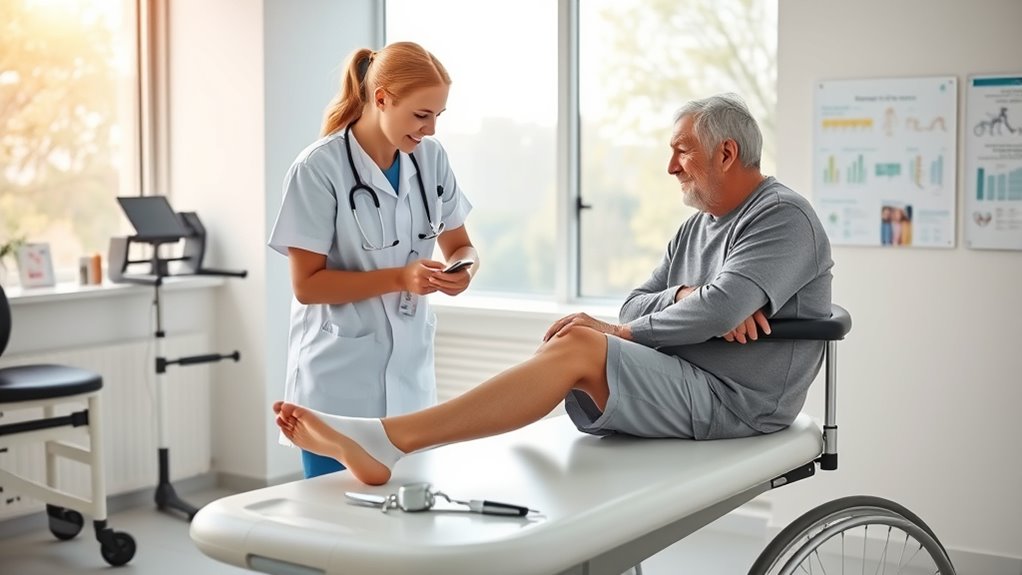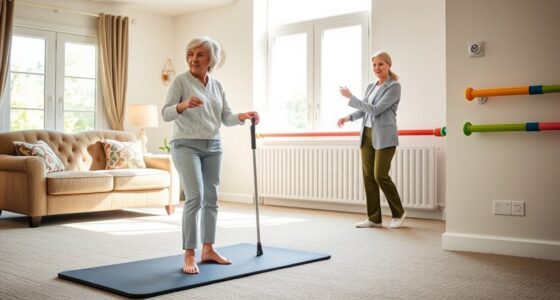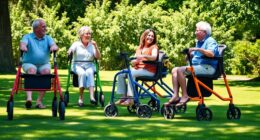To manage orthopedic comorbidities in Parkinson’s care, regularly assess your bone health, balance, and muscle strength to catch issues early. Tailor physical therapy with gentle, consistent exercises that improve flexibility and posture. Monitor how medications affect your musculoskeletal health and work closely with your healthcare team to optimize treatment plans. Use assistive devices, modify your environment, and practice fall prevention strategies. Continuing with this approach helps you maintain mobility and quality of life more effectively.
Key Takeaways
- Regularly assess bone density and gait stability to prevent fractures and falls.
- Implement personalized physical therapy focusing on flexibility, strength, and postural control.
- Monitor medication effects to balance motor improvements with musculoskeletal side effects.
- Coordinate preoperative and postoperative care for orthopedic procedures to optimize recovery.
- Remove environmental hazards and promote assistive device use to reduce fall risk and enhance mobility.
Assessing Orthopedic Risks in Parkinson’s Patients

Evaluating orthopedic risks in Parkinson’s patients is essential for preventing fractures and mobility issues. You should regularly assess bone health, as Parkinson’s can increase osteoporosis risk, making bones more fragile. Keep an eye on gait stability and balance, since uneven steps or shuffling increase fall risk. Check for muscle weakness or rigidity that could impair movement or cause joint strain. Pay attention to postural changes, like stooping or leaning, which can affect stability. Review medication effects, as some treatments may influence coordination or cause dizziness. Conduct extensive evaluations to identify areas of concern early. Understanding the importance of Contrast Ratio can help in assessing the clarity and depth of visual information, which may be relevant for patients with visual or perceptual deficits. This proactive approach helps you implement targeted interventions, reducing the chance of injuries and preserving your mobility and independence over time.
Tailoring Physical Therapy for Joint and Muscle Health

After identifying orthopedic risks in Parkinson’s patients, customizing physical therapy becomes essential to support joint and muscle health. You should focus on gentle, targeted exercises that improve flexibility, strength, and posture, reducing stiffness and imbalance. Incorporate low-impact activities like stretching, range-of-motion drills, and resistance training tailored to each patient’s abilities. Consistency is key—regular sessions help maintain mobility and prevent deterioration. Pay attention to patient feedback; modify exercises if they experience pain or fatigue. Educate patients on proper movement techniques to avoid strain and injury. Use assistive devices if needed, and ensure a safe environment for exercises. By personalizing therapy plans, you help your patients preserve function, reduce discomfort, and enhance their overall quality of life.
Medication Management and Its Impact on Musculoskeletal Conditions

Medications used to manage Parkinson’s disease can markedly influence musculoskeletal health, sometimes improving mobility but also posing risks for orthopedic issues. Levodopa and dopamine agonists often enhance movement, reducing rigidity and stiffness. However, these medications can lead to side effects like dyskinesias—uncontrolled movements—that strain joints and muscles. Over time, some drugs may cause muscle weakness or imbalance, increasing fall risk and injury. Proper medication timing and dosage are vital to minimize these effects. Regular monitoring helps you identify adverse reactions early, allowing adjustments that support both motor control and musculoskeletal health. Additionally, understanding medication side effects and their impact on musculoskeletal conditions can provide insight into comprehensive Parkinson’s management. Balancing medication benefits with potential orthopedic risks is essential for maintaining mobility and preventing secondary musculoskeletal problems in Parkinson’s care.
Surgical Interventions and Rehabilitation Considerations

Surgical interventions, such as deep brain stimulation (DBS), can considerably improve motor symptoms in Parkinson’s patients, but they also require careful planning for orthopedic and rehabilitation needs. You’ll need to evaluate bone health and joint stability before surgery to prevent complications. Postoperative rehab should focus on restoring mobility, strength, and balance while considering the patient’s unique orthopedic issues. Coordination with orthopedic specialists helps optimize recovery and prevent issues like fractures or joint dislocations. You should also monitor for potential surgical side effects that could impact mobility, such as swelling or muscle weakness. Tailoring rehabilitation programs to accommodate Parkinson’s symptoms and orthopedic conditions ensures better outcomes. Additionally, preoperative assessment of the patient’s orthopedic status can help identify potential risks and guide the development of a personalized rehabilitation plan. Incorporating natural materials and textures into the rehabilitation environment can enhance comfort and promote a soothing recovery process. Implementing digital literacy programs can also support seniors in engaging with rehabilitation technology and enhancing their recovery experience. Ultimately, a multidisciplinary approach that integrates surgery and rehab planning enhances both motor function and overall quality of life.
Strategies for Fall Prevention and Maintaining Mobility

To effectively prevent falls and maintain mobility in Parkinson’s patients, you need to implement targeted strategies that address both motor symptoms and orthopedic vulnerabilities. Focus on the following:
- Regular balance and strength training exercises to improve stability.
- Removing hazards like loose rugs and clutter from walkways.
- Using assistive devices such as canes or walkers for added support.
- Ensuring proper footwear that provides traction and stability.
Additionally, consider environmental modifications like installing grab bars and adequate lighting. Staying active helps preserve mobility and reduces fall risk. Consistent medication management and physical therapy can also improve coordination. By combining these approaches, you create a safer environment and promote independence for Parkinson’s patients.
Frequently Asked Questions
How Do Comorbidities Influence Parkinson’S Disease Progression?
You might wonder how comorbidities affect Parkinson’s progression. They can complicate symptoms, making movement and balance worse, and increase your risk of complications like falls or infections. Managing these conditions effectively can slow overall decline and improve quality of life. By staying proactive and coordinating care, you help prevent comorbidities from accelerating Parkinson’s progression, allowing you to maintain independence and better manage your symptoms over time.
What Role Do Nutrition and Diet Play in Orthopedic Health Management?
Nutrition and diet are the backbone of your orthopedic health, shaping your body’s ability to heal and strengthen bones and joints. Think of your diet as a building blueprint, guiding the construction of a sturdy framework. You should focus on calcium, vitamin D, and protein-rich foods to support bone density and muscle strength. Proper nutrition fuels your body’s defenses, helping you stay active and resilient against orthopedic issues.
Are There Specific Exercises Recommended for Different Stages of Parkinson’S?
You should tailor exercises to your Parkinson’s stage, focusing on maintaining mobility and strength. In early stages, gentle stretching and balance exercises help keep you active. As the disease progresses, you might need more supportive activities like seated exercises or aquatic therapy. Always consult your healthcare team to develop a personalized plan. Regular, appropriate exercise can improve your quality of life and help manage symptoms effectively.
How Can Caregivers Effectively Support Orthopedic Care Plans?
You can effectively support orthopedic care plans by staying informed about your loved one’s specific needs and encouraging consistent adherence to prescribed exercises. Help them stay motivated, assist with mobility exercises safely, and guarantee they follow their healthcare team’s recommendations. Regularly communicate with healthcare providers to address concerns, monitor progress, and adjust the plan as needed. Your active involvement and encouragement are key to maintaining their orthopedic health and overall well-being.
What Emerging Therapies Show Promise for Orthopedic Issues in Parkinson’S?
Ever wonder if magic potions or futuristic gadgets could fix orthopedic issues in Parkinson’s? While no miracle cure exists yet, emerging therapies like stem cell treatments and targeted physical therapy show promise. New approaches focus on improving mobility and reducing pain. You should stay optimistic, as ongoing research aims to develop effective solutions, helping you manage these challenges better and maintain quality of life.
Conclusion
As you navigate Parkinson’s care, picture yourself guiding your loved one through a safe, steady path. With tailored therapies and mindful medication choices, you help them stand tall and move confidently, like a sturdy tree rooted deep in the ground. By preventing falls and addressing orthopedic concerns, you create a brighter, more stable future—where each step is deliberate and each movement feels secure. Together, you foster strength, resilience, and hope along the journey.









